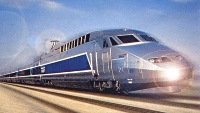TGV high-speed train begins commercial service between Paris and Strasbourg
The TGV high-speed train began commercial service between Paris and Strasbourg, halving travel time between the two cities to 2 hours 20 minutes.

The train made its maiden voyage with 360 passengers on board early Sunday, arriving on time and continuing on to the German city of Stuttgart, said Anne Premel, spokeswoman for the Strasbourg municipality. Passengers who got off in the Alsatian capital were greeted with local music and bretzels pretzels the size of a pizza, a local specialty.
The line, on which the TGV broke its own world speed record for conventional rail trains in April when the bullet train reached 574.8 kilometers per hour (357 miles per hour), was inaugurated by Prime Minister Francois Fillon on Saturday.
"Strasbourg just over two hours from Paris, that was a dream. The dream is now fulfilled," he said. The previous fastest connection between the two cities took 4 hours.
Trains on the new 406-kilometer (252-mile) line reaching Strasbourg via Reims, Metz and Nancy with the first 300 kilometers (186 miles) on dedicated high-speed tracks will travel at speeds of up to 320 kph (199 mph), compared to a maximum of 300 kph (186 mph) for current TGV trains.
Different branches of the line will also cut travel time from Paris to several other European cities. The train to Frankfurt takes 3 hours 50 minutes and to Stuttgart, Germany, 3 hours 40 minutes. A trip to the Swiss city of Zurich takes 4 hours 30 minutes.
For Strasbourg, the TGV will mean more tourists, better business opportunities and a possible real estate boom. But Mayor Fabienne Keller noted it was largely the municipality, not the central government, that had secured the high-speed rail network's extension.
"Alsace largely fought it out itself. The TGV wasn't offered to it," she said, referring to the 20-year battle over the financing of the project worth the EUR3.2 billion (US$4.3 billion) or a total of EUR5.5 billion (US$7.43 billion) with trains included which eventually found backing from 22 partners including the EU, the French and Luxembourg governments, train operators and French regional governments.
Planners now foresee a network of high-speed lines stretching from Barcelona, Spain, to Budapest, Hungary. The plans are to create two axes that meet in Strasbourg: one running between Paris, Munich, Vienna and Budapest; the other linking Hamburg, Frankfurt, Lyon and Barcelona.
The EU has earmarked EUR20.35 billion (US$27.5 billion) to finance trans-European networks, much of it to five priority transcontinental rail links, which are due to be completed by 2015.
A new rail bridge over the Rhein River to Germany is expected to be open in 2011.
Subscribe to Pravda.Ru Telegram channel, Facebook, RSS!


